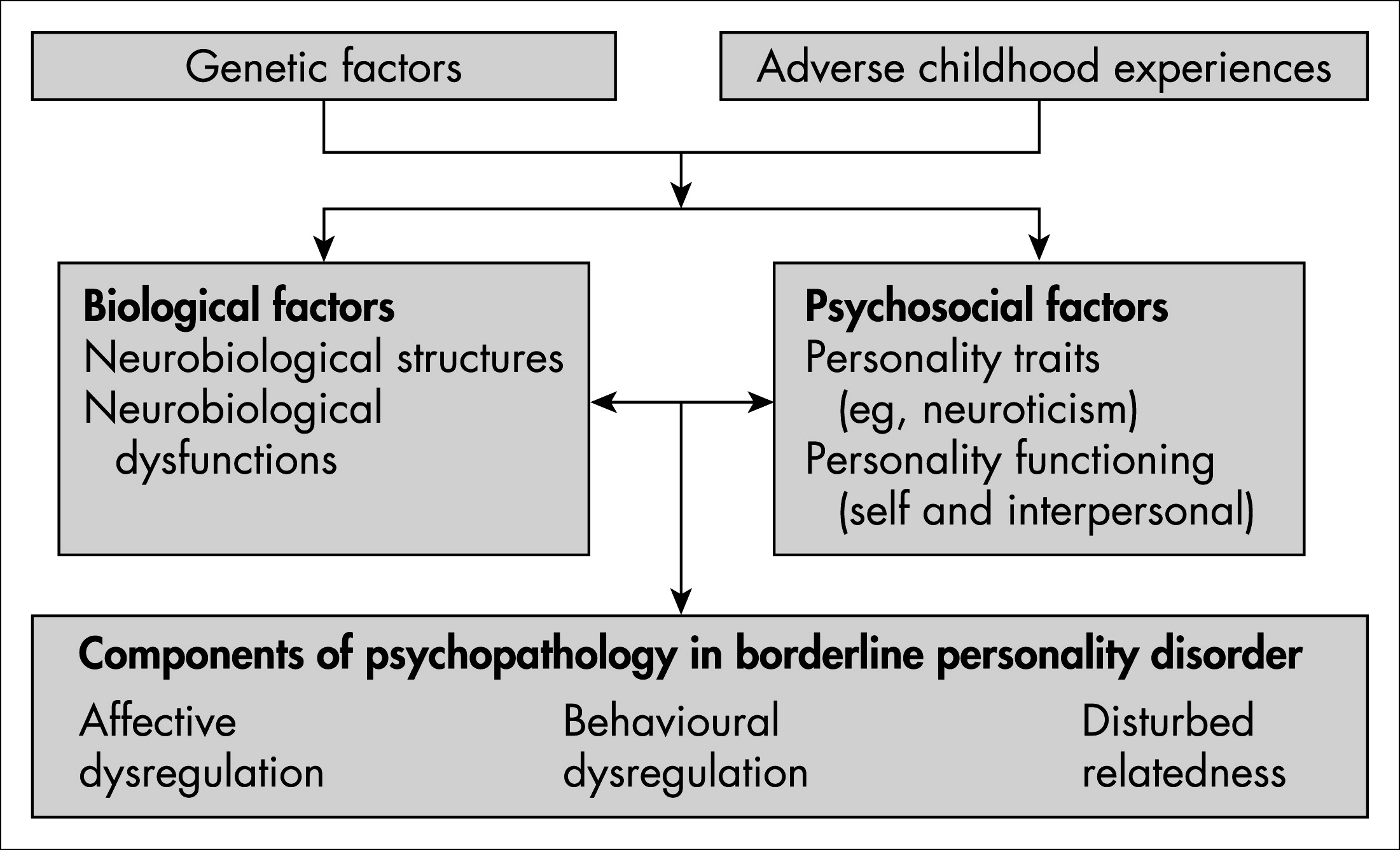Borderline Personality Disorder
Abstract
Introduction
Epidemiology
Diagnosis
Course
Comorbidity
Psychosocial factors in the development of borderline personality disorder

Genetic factors and neurobiology
Neuroimaging
Anatomical MRI findings
PET
Functional MRI findings
Treatment
Pharmacotherapy
| Treatment | Mean dose | |
|---|---|---|
| Bogenschutz et al89 | Olanzapine vs placebo | 6.9 mg per day |
| de la Fuente et al92 | Carbamazepine vs placebo | Blood concentration 6.4–7.1 μg/mL |
| Frankenburg et al82 | Sodium valproate vs placebo | 850 mg per day |
| Goldberg et al87 | Tiotixene vs placebo | 8.7 mg per day |
| Hollander et al93 | Sodium valproate vs placebo | Blood concentration 64.6 μg/mL |
| Hollander et al94 | Sodium valproate vs placebo | 1325 mg per day |
| Leone et al88 | Loxapine vs placebo | 14.4 mg per day |
| Leone et al88 | Chlorpromazine vs placebo | 110 mg per day |
| Pascual et al100 | Ziprasidone vs placebo | 81 mg per day |
| Reich et al96 | Lamotrigine vs placebo | 25–275 mg per day |
| Rinne et al86 | Fluvoxamine vs placebo | 150 mg per day |
| Salzman et al85 | Fluoxetine vs placebo | 40 mg per day |
| Schulz et al97 | Olanzapine vs placebo | 2.5–20 mg per day |
| Shafti and Shahveisi98 | Olanzapine vs haloperidol | 2.5–10 mg per day |
| Soloff et al84 | Haloperidol vs amitriptyline vs placebo | 4.8 mg per day; 149.1 mg per day |
| Soloff et al83 | Haloperidol vs phenelzine sulfate vs placebo | 3.9 mg per day; 60.45 mg per day |
| Zanarini et al90 | Olanzapine vs placebo | 5.3 mg per day |
| Zanarini et al95 | Omega-3 fatty acids vs placebo | 1 mg per day |
| Zanarini et al91 | Olanzapine vs fluoxetine vs olanzapine plus fluoxetine | 3.3 mg per day; 15.0 mg per day; 3.2 mg per day plus 12.7 mg per day |
| Ziegenhorn et al99 | Clonidine vs placebo | 0.45 mg per day |
Psychotherapy
| Treatment | Comparison | |
|---|---|---|
| Bateman and Fonagy109 | Mentalisation-based treatment in a partial hospital setting | Treatment as usual |
| Bateman and Fonagy118 | Mentalisation-based psychodynamic treatment | Structured clinical management |
| Blum et al120 | Brief cognitive-behavioural therapy plus treatment as usual | Treatment as usual |
| Bohus et al121 | Inpatient dialectical behaviour therapy | Treatment as usual |
| Clarkin et al122 | Transference-focused therapy | Dialectical behaviour therapy as supportive therapy |
| Cottraux et al123 | Cognitive-behavioural therapy | Client-centred therapy |
| Davidson et al119 | Brief cognitive-behavioural therapy plus treatment as usual | Treatment as usual |
| Doering et al132 | Transference-focused therapy | Community treatment by experienced therapists |
| Farrel et al124 | Schema-focused therapy plus treatment as usual | Treatment as usual |
| Giesen-Bloo et al125 | Schema-focused therapy | Transference-focused therapy |
| Gregory et al126 | Dynamic deconstructive therapy | Treatment as usual |
| Harned et al127 | Dialectical behaviour therapy | Community treatment by experts |
| Koons et al114 | Dialectical behaviour therapy | Treatment as usual |
| Linehan et al110 | Dialectical behaviour therapy | Treatment as usual |
| Linehan et al112 | Dialectical behaviour therapy | Treatment as usual |
| Linehan et al111 | Dialectical behaviour therapy | Comprehensive validation therapy plus a 12-step substance misuse programme |
| Linehan et al128 | Dialectical behaviour therapy | Therapy by experts |
| McMain et al129 | Dialectical behaviour therapy | Psychodynamically informed clinical management |
| Munroe-Blum et al116 | Psychodynamic therapy | Interpersonal group therapy |
| Soler et al130 | Dialectical behaviour therapy skills training | Standard group therapy |
| Tyrer et al117 | Brief cognitive-behaviour therapy | Treatment as usual |
| Turner et al115 | Dialectical behaviour therapy | Client-centred therapy |
| Verheul et al131 | Dialectical behaviour therapy | Treatment as usual |
| Weinberg et al133 | Brief cognitive-behavioural therapy plus treatment as usual | Treatment as usual |
Pharmacotherapy with psychotherapy
Future perspectives
References
Information & Authors
Information
Published In
History
Authors
Metrics & Citations
Metrics
Citations
Export Citations
If you have the appropriate software installed, you can download article citation data to the citation manager of your choice. Simply select your manager software from the list below and click Download.
For more information or tips please see 'Downloading to a citation manager' in the Help menu.
View Options
View options
PDF/EPUB
View PDF/EPUBGet Access
Login options
Already a subscriber? Access your subscription through your login credentials or your institution for full access to this article.
Personal login Institutional Login Open Athens loginNot a subscriber?
PsychiatryOnline subscription options offer access to the DSM-5-TR® library, books, journals, CME, and patient resources. This all-in-one virtual library provides psychiatrists and mental health professionals with key resources for diagnosis, treatment, research, and professional development.
Need more help? PsychiatryOnline Customer Service may be reached by emailing [email protected] or by calling 800-368-5777 (in the U.S.) or 703-907-7322 (outside the U.S.).

